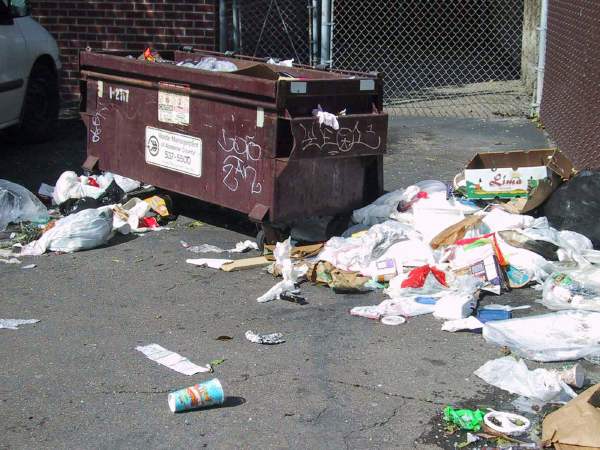
Can you imagine a steel box standing in full sun on a nice summer’s day while hamburgers, chicken bones, French fries, soft drink remains, food wrapping, and packaging rot within? What a wonderful aroma. The dumpster is completely full to overflowing and yet more trash bags have been tossed on the ground. The drain plug is gone and a fermenting liquid oozes all over the dumpster pad. Finally, the dumpster’s split seam gets wider every time the garbage truck picks it up and empty’s it.
Rats (mice, roaches, ants, flies…) will lodge close by and hone in on this evening buffet. They will have access to the edible trash on the ground, and get into the dumpster through the drain plug, split seam, and open top.
Rats and blowflies consider the overloaded dumpster as a haven with a feast fit-for-a-king. Fruit flies are enticed by rotting fruits and vegetables. Other pests, such as mice, bees, wasps, and cockroaches, enticed by the dumpster, find their way into adjacent buildings.
Sanitation technicians are advised never to ignore dumpster problems and to be familiar with accepted sanitation management practices and techniques relating to dumpsters. Technicians should report problems with dumpster whenever they see them. The sanitation industry lists some of the following dumpster management practices to reduce rat (and other pest) problems…
Managing your Dumpster
- Locate your dumpster 50 to 100 feet from any doors.
- Locate your dumpster on a solid concrete pad that has foundation toes on the outside to keep rats from burrowing under the pad. If installation on a pad is not possible many dumpsters can be on wheels to keep them of the ground.
- The dumpster pad should slope to a sanitary sewer drain to handle runoff from cleaning.
- There should be no plantings around the dumpster enclosure. These become hiding places for rats and other vermin. And robust landscaping makes it difficult to inspect the Dumpster.
- Make sure you trim all weeds and grass.
- The dumpster lid should always be closed. If you routinely have so much trash that the lid will not close, you need a larger dumpster or more frequent trash pick-ups. Have all users close all doors when using the dumpster.
- Have your staff available during trash pick-up to clean under the dumpster.
- Clean your dumpster regularly using a high-pressure hose and degreasing solution.
- Keep the drain hole closed or screened at all times (except when cleaning)
- Inspect your dumpster regularly for damage, leaks, rust, and for lids and doors that will not close correctly and easily. Damaged dumpsters should be replaced and your trash service agreement should indicate that your dumpster will be “refreshed” on a regular basis.
- Instruct users to place, not toss, trash into the dumpster.
- All food waste should be placed in heavy-duty plastic trash bags and tied off before being placed into your dumpster.
- Your Dumpster should be inspected twice daily. Trash outside the dumpster should be picked up and placed into the dumpster. Inspect the area around the dumpster when the dumpster is emptied or removed.
You owe it to your business to properly maintain your dumpster. Not many businesses can afford a fine by the health department and you will want to do everything you can to keep your rat and pest problems under control. And in many jurisdictions it is up to the business owner to properly maintain their waste container.
Here is a short and well done video about how to maintain dumpsters. Though the video was done for the Colorado Coalition for School I.P.M., I find it equally informative for businesses.
Call today at 1-800-986-1006 for a free rodent inspection. You’re also welcome to complete our contact form and a caring Hearts Pest Management representative will contact you shortly.
Rats and Dumpsters Bibliography
“Dumpster.” Wikipedia, the free encyclopedia. Web.
